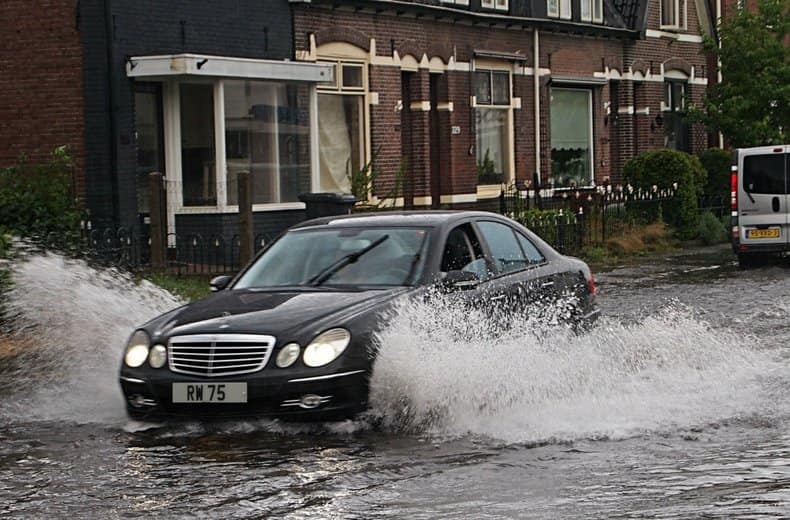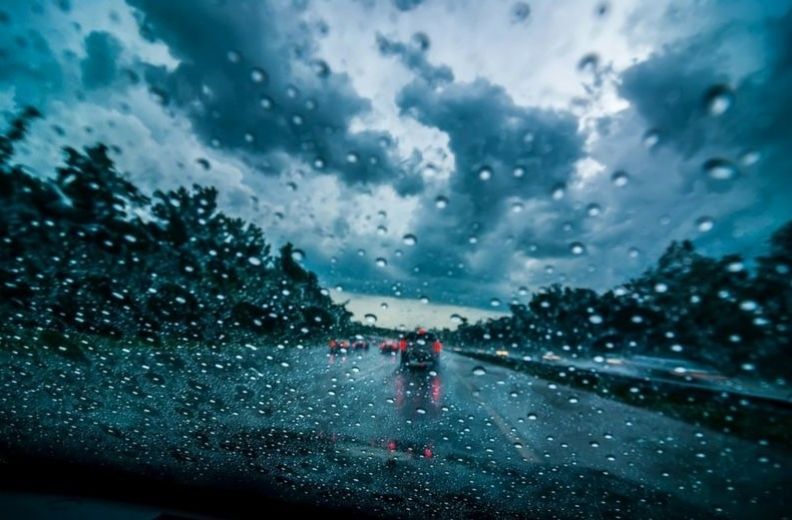Breakdown numbers always increase during periods of wet weather as the damp causes problems with engines and electrical systems and it is easy to flood your engine when driving through water, if done so incorrectly.
If you must drive, there are a handful of steps you can take to reduce your chances of an accident or breakdown in wet weather.
How to prepare for driving in heavy rain

Firstly it is always advisable to consider before you set off whether your journey is essential.
If not, can it be delayed until after the rain has subsided?
If so then plan your journey in advance, taking care to avoid areas which are prone to flooding, and factor in extra time to allow for slower speeds and potential congestion.
It is also a good idea to let relatives and friends know your intended route and expected time of arrival and where possible, travel with others.
Use our checklist below or watch our video on how to check your car before you set off in winter.
Before you go:
- Check that your windscreen wiper blades are fully functional. If both front and back blades are not up to scratch, get them replaced.
- On an older vehicle, it might be advisable to upgrade to so-called ‘aero’ wipers, which are more effective at removing water from the windscreen, particularly at speed
- Try to fill up with fuel before you travel, as getting stuck in traffic will increase your fuel consumption - Remember, with the lights, heater and wipers switched on, your fuel economy will be reduced even further
- Listen out for local news bulletins to keep up-to-date with road closures, flooding and forecasts
- Carry a mobile phone in case you encounter any difficulties during your journey
- Check that your tyres are of the recommended legal tyre tread depth so you can be sure you have a safe amount of grip on the roads. For more checks you can do before driving visit our under the bonnet checks page
Here's how to check your windscreen wipers before you set off.
Here's how to check your tyre tread depth.
How to drive in heavy rain
- Slow down. Reduce your speed and leave more space between you and the vehicle in front as stopping distances in rain are increased
- Use dipped headlights so that other drivers can see you more easily
- Don’t use rear fog lights. They can mask your brake lights and dazzle drivers behind you
- Look out for large or fast-moving vehicles creating spray which reduces visibility
- Keep your air conditioning on, as this will stop your windows from misting up - furthermore, you can read our full advice page on how to demist your windscreen in double-quick time
- Listen out for local news bulletins to keep up-to-date with road closures, flooding and forecasts
- If you break down in torrential rain keep the bonnet closed while waiting for help to arrive, to avoid the electrical system getting soaked
- Driving too fast through standing water could lead to tyres losing contact with the road. If your steering suddenly feels light you could be aquaplaning. To regain grip, ease off the accelerator, do not brake and allow your speed to reduce until you gain full control of the steering again
- Be considerate to other road users and try not to spray pedestrians and cyclists as you drive through water
Heavy rain may lead to large puddles, areas of standing water and even flooding in the event that you may have to negotiate these types of conditions on the road, read below for our advice on how to drive through deep puddles.

Complete peace of mind for less
• Cheaper than AA Price Promise or your money back^
• We get to most breakdowns in 60 mins or less
• Our patrols fix 4/5 breakdowns on the spot

Stopping distances in the rain
The Highway Code states that stopping distances will be at least double in wet weather, because your tyres will have less grip on the road.
Reduce your speed and leave more space between you and the vehicle in front to account for greater stopping distances – remember the two-second rule?
Well increase it to four if it begins to pour.
How to drive through water and floods

“Puddles” may conjure an image of a small drop, but some can develop into sizable bodies of water.
Driving through these puddles incorrectly could cause serious damage to your car not to mention cost an extortionate amount to repair.
As a result we’ve put together some top tips for driving through them:
- Size up the water first – even if it means you have to stop your car and get out (getting a bit wet is a lot better than being left stranded). If the water is muddy you might not be able to see the bottom and gauge its depth. Try and find a stick or an object to find the lowest point.
- If you suspect it’s too deep, or you can't be sure, always find another way to your destination. Modern vehicles’ door seals are good and keep water out, but this can make a car buoyant, meaning it could begin to float if the water gets too deep leaving you stranded. Even in this instance the water will eventually find its way in.
- If the puddle is shallow enough to drive through, try and spot any objects that may cause damage to your car’s wheels, tyres or suspension, potentially leaving you mid-puddle with a problem. This way you can pick a safe path across.
- Once you’ve confirmed you can drive through the puddle and determined your route, keep your vehicle in a low gear (second is generally adequate) and engine revs up. This will help you maintain momentum when you travel through the puddle, creating a bow wave so you don’t get bogged down.
- Once you exit the other side – and especially if the puddle is on the deep side – pause for a moment if you can to let any excess water drain away and flow back to where it came from.
- If you can’t, be aware that grip levels on the road ahead will be diminished, as fluid from the puddle is dropped along the Tarmac by other cars.
- It’s always worthwhile gently brushing your brake pedal on exit, creating some friction and therefore heat to evaporate off any excess moisture. Some luxury vehicles can sense when you’ve navigated a puddle and automatically do this for you, keeping braking performance as effective as possible.
Shallow puddles are not the most arduous obstacles to overcome, but it’s still important to remember that on the other side of a puddle grip levels could be lower.
Adjust your speed to suit the depth of the water, too.
If the obstruction is deeper, take more time and care when crossing it.
A few minutes planning could save you plenty of time – and money – in having your car repaired. And never attempt to drive through fast flowing water – you could easily get swept away.
What to do if you break down in the rain
If you break down in torrential rain, keep the bonnet closed while waiting for your RAC Breakdown patrol, to avoid the electrical system getting soaked.
RAC statistics show breakdown numbers increase significantly during periods of wet weather, as the damp causes problems with the engines and electrical systems, particularly in older vehicles.
If your engine cuts out after driving through deep water, do not attempt to restart it, as engine damage may occur – instead, turn on the hazard lights, call for assistance and have the vehicle professionally examined.
Catastrophic flood-related engine damage is typically caused by water being sucked into the engine, which causes the engine to lock up (mechanics call it an ‘air lock’) and can in turn damage important engine components such as piston connecting rods and valves.
This inevitably means a new engine will have to be fitted, but what people generally don’t understand is that it is the owner who is likely to have to foot the expensive garage bill, unless they can demonstrate to their insurer – like in any accident – that it was not their actions that caused the damage.
For more information on how to prepare for driving in difficult weather conditions, visit our winter driving advice page.
Did you know that RAC offers Business Breakdown Cover? Don't leave it until its too late - speak to the RAC today.
RAC Breakdown Cover
Join the RAC and get Breakdown Cover. Our patrols fix most breakdowns on the spot, with repairs done in just 30 minutes on average.


Services we offer
- Breakdown Cover
- European Breakdown Cover
- Motorbike Breakdown Cover
- Electric Car Breakdown Cover
- Caravan, Motorhome and Campervan Breakdown Cover
- Business Breakdown Cover
- Van Breakdown Cover
- RAC Approved Garages
- Vehicle servicing
- Vehicle repair
- MOTs
- Mobile mechanics
- RAC Tyres
- RAC Approved Dealers
- RAC Shop
- myRAC app
















